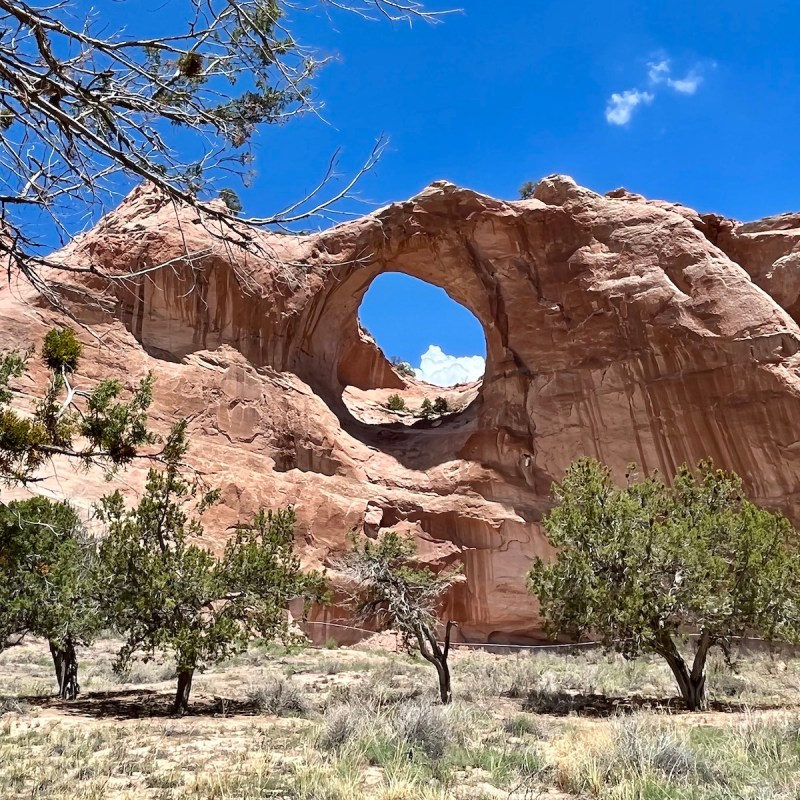
When it comes to capitals, Window Rock, Arizona, stands out for a number of reasons. First, there’s the magnificent red sandstone arch that the town is named for. And then there is the fact that Window Rock serves as the headquarters and capital of the Navajo Nation, the largest sovereign Native American nation in the United States.
Videos by TravelAwaits
Add in the authentic Navajo culture that is on display virtually everywhere — from museums to monuments to trading posts — and you have a capital-city destination unlike any other.
Although a small city of about 2,500, Window Rock is huge in Navajo (Diné) history. It sits along the eastern border of Arizona, just a few minutes’ drive from the western border of New Mexico. Window Rock’s status as the capital of the Navajo Nation dates back to 1936, but the site has been significant to the Navajo people for much longer. In fact, the ceremonial name for the area translates to Center of the World.
Today, Window Rock serves not only as the center of the Navajo government, but also as a base for taking in ancient and modern Navajo history, fascinating trading post culture, and awe-inspiring landscapes. When I visited Window Rock on an August road trip, I was struck by Window Rock’s easy accessibility to many of the Navajo Nation’s most famous features.
Here are nine not-to-be-missed experiences in Window Rock, Arizona.

1. Explore The Namesake Window Arch
I knew going in that Window Rock would have amazing rock formations. But nothing could prepare me for the town’s massive 200-foot sandstone arch that, true to its name, frames a spectacular view of the deep blue Arizona sky.
The arch is the centerpiece of the beautiful Window Rock Navajo Tribal Park & Veterans Memorial, just steps from the Navajo Nation Office of the President and Vice President. An easy trail of less than a quarter mile runs through the park, allowing visitors to get fairly close to the arch, although no climbing is allowed on the arch or the rocks surrounding it.
Derived from the Navajo word Tségháhoodzání, the Window Rock arch was chosen as the site for the Navajo Nation Headquarters because of the area’s history and cultural significance — particularly with the traditional Navajo Waterway Ceremony. Discover Navajo notes that in Navajo culture and history, there was once a water pond right below the arch where a Navajo medicine man would collect water to use in the Waterway Ceremony.
Although you likely won’t witness a ceremonial water collection while visiting today, the Navajo Nation stresses that the area is sacred and should be respected.

2. Learn Native History At The Navajo Nation Cultural Museum
For a multifaceted look at the history of the Navajo people, the excellent Navajo Nation Cultural Museum should be among visitors’ first stops.
The exhibits walk visitors through the rich and unique history of the Navajo people, using photos, maps, artifacts, and works of art to help tell their stories. The exhibits also include a retrospective on the Code Talkers as seen through the lens of Japanese photographer Kenji Kawano.
On the grounds of the museum, visitors can take in an authentic hogan, the traditional home of the Navajo people. Along with its informative exhibits, the Navajo National Cultural Museum also features a book and gift shop, snack bar, auditorium, outdoor amphitheater, information kiosk, and library.

3. Browse For Navajo Art At The Hubbell Trading Post National Historic Site
A drive of less than a half-hour west of Window Rock will take visitors to the oldest operating trading post on Navajo Nation territory.
Located near the town of Ganado, the Hubbell Trading Post National Historic Site offers a fascinating look at the history of John Lorenzo Hubbell. He was a trader who bought the Hubbell Trading Post in 1878 and went on to become the foremost Navajo trader of his time.
After checking out the unique goods and art pieces at the trading post, visitors can walk around the grounds of the national historic site and take in the stables, gardens, and informative visitor center.

4. Be Inspired By The Navajo Code Talkers
Upon arrival in Window Rock, it is immediately apparent that the heroic World War II Code Talkers hold a special place in Navajo history. Among many tributes to the Code Talkers is the Veteran’s Memorial, which was established at the base of the Window Rock arch in 1995 to honor the many Navajo men and women who have served in the U.S. military.
The most famous of those veterans are the Code Talkers, the Navajo servicemen in World War II who used the native Diné language to create a code that was never broken by the enemy. “Historians credit the Navajo Code Talkers for helping to win World War II,” says the nation’s website.
Visitors will see signs and memorials all over the Navajo Nation honoring the Code Talkers, including the moving Veterans Memorial statue of a Navajo soldier talking into a radio and carrying a large radio transmitter on his back.

5. Gaze At Amazing Shiprock
Soaring 7,178 feet above sea level, the jagged rock formation known as Shiprock Peak can be seen for miles around. It rises abruptly from the desert floor about an hour and a half north of Window Rock and about 15 miles southeast of Shiprock, New Mexico.
Taking in the unique volcanic rock formation is definitely worth the drive if you’re visiting Window Rock.
Although named “Shiprock” by Anglo settlers, the rock is known to the Navajo as Tsé Bit’ a’í, or “rock with wings.” Shiprock is a sacred site to the Navajo people, and hiking and/or climbing it, or the surrounding rocks, is forbidden. Also, driving onto the dirt road leading to the formation is prohibited. Visitors should view and photograph the pinnacle from a paved roadway (Indian Service Route 13 or U.S. Highway 49). There are a number of places to pull over alongside the paved roads to get a good view of Shiprock.

6. Explore Nearby Gallup
Historic Route 66, beautiful red rock terrain, thriving Navajo art shops, and authentic Mexican cuisine await just a half-hour southeast of Window Rock in Gallup, New Mexico.
Because of its convenient location on a stretch of old Route 66, as well as the major east-west Interstate 40, Gallup makes a great base for exploring Window Rock, Ganado, and Shiprock. Visitors will find a robust selection of hotels and restaurants to choose from and a fun mashup of cultures.
I loved the vintage Route 66/southwestern vibe at the El Rancho Hotel and the green-and-green-chili Mexican cuisine choices at Jerry’s Café. For browsing Navajo jewelry, rugs, or pottery, it’s hard to beat the enormous selection at Richardson Trading Post located right on Route 66.

7. Hike Gallup’s Church Rock
For a chance to get out into the region’s red rocks, the towering Church Rock in Gallup is a perfect choice. Located in Gallup’s Red Rock Park and near the little town of Church Rock, New Mexico, the trail offers stunning views of the steeple-like spire that makes up Church Rock.
The trail is considered moderately challenging and takes hikers up a series of rocky steps and along narrow ridges. The out-and-back route is about 2.6 miles and takes about an hour and a half to complete. It offers great views of the valley below and even better views of the rock formation. When I hiked the trail in August, it was lined with lush greenery and wildflowers.

8. Take In Gorgeous Canyon De Chelly
Window Rock is also within an easy day trip of the iconic Canyon de Chelly National Monument, known worldwide for its sacred canyon walls, ancient ruins, and the distinctive Spider Rock. The national monument is located about 70 miles northwest of Window Rock.
Discover Navajo notes that nowhere in Navajoland is the blend of past tradition and present culture more evident than in Canyon de Chelly. “The Navajo people still have a mystical bond to this redstone canyon that cuts an almost tropical path of trees and flowers through the desert,” says the website. The canyon is home to native culture dating from 350–1300 AD, and its 26 miles of sheer cliffs climb to more than 1,000 feet.
Visitors can take in the canyon by driving along two paved scenic rim drives and overlooks, as well as participating in ranger-led programs. A number of private tours are also available.

9. Stay In A Hogan
For a cultural experience to remember, Discover Navajo suggests staying in a traditional, eight-sided, one-room home called a hogan.
“This is a primitive way of life — a traditional way of life,” says the website. “There is no electricity, running water, or luxury when staying in a hogan, only Mother Earth and the beauty of the natural surroundings.”
At Canyon de Chelly National Monument, the Spider Rock Campground, which is located in a natural wooded area of the Tse Ho Tso Plateau, allows visitors to camp in RVs, tents, or cozy hogans. Nearby Chinle also offers a number of lodging and dining choices.
Pro Tips
When I visited the Navajo Nation in August 2022, face mask requirements were still in effect for public buildings, and the requirement appeared to be strictly enforced. Information on the nation’s evolving COVID-19 restrictions is available here.
The Navajo Nation observes Mountain Daylight Saving Time from March through November, unlike the rest of Arizona, which stays on Mountain Standard Time year-round.
Arizona offers a wealth of activities for all walks of life, including:

